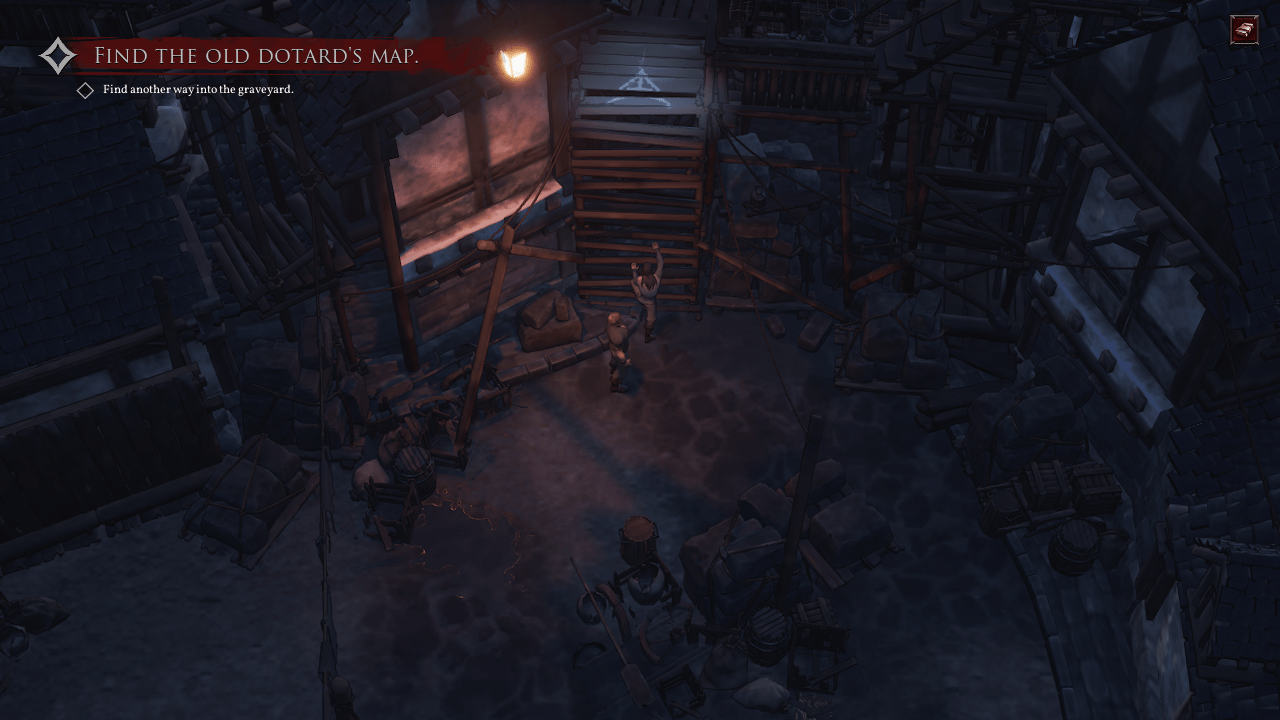Sailing in from the high seas comes Flint: Treasure of Oblivion. Flint is a tactical RPG by developer Savage Level. Set during the golden age of piracy, you take the role of Captain Flint and his shipmate Billy Bones primarily. You start off on a floating piece of your wrecked ship, just you and Billy starving. Billy starts to look appetising and so you learn the movement controls by chasing Billy around the wreckage briefly before you are picked up by a navy ship. Not believing your cover story, the Captain throws you both in prison when you get to the mainland.
Of course you manage to escape, but before you can do that you have things to do around the prison. You are free to explore the area as you wish, items of interest are outlined in yellow when you get close enough and people you can talk to have an exclamation mark above their heads. Items are important for surviving combat encounters so make sure you check everywhere for these valuables.
There are very few cutscenes or spoken dialogue in Flint, the story is told through comic panels. All of your conversations and action outside of combat are shown in this way, being a long time comic reader I really liked this method. At certain times you will get a choice of dialogue, and these will make a difference to the outcome of your conversation. Even when it went badly though I still enjoyed being able to influence the story a little.
There is a nice balance between story elements and action, and there is a lot of both.


Combat in Flint is dice based. Each character, both yours and the enemy, gets two action points each. You can use these to move twice, fight twice if you are next to an enemy or a combination of the two. Some actions may take up both action points, for instance reloading a musket will take up that characters whole turn. If an enemy is within your movement range you can decide to charge at them which will cause a dice to be rolled to see whether you tackle him, push him, stumble or get a status quo result, meaning neither of you gets hurt. You can re-roll the result as many times as you like if you have enough re-rolls, these are one of those important items you can find during exploration, use them wisely for they can be the difference between victory and defeat.
When you are next to an enemy and haven’t moved that turn you can attack them twice, a number of dice are rolled depending on what type of weapon you have if any. If say you roll two dice and both are a success, you will hit the enemy twice in that one action, if they fail then you swing at them but do no damage. You will see this work the same for the enemy when they attack you, even seeing the dice they roll and how many action points they have. It is possible to increase your action points through use of skills, Captain Flint has one that gives one AP to everyone in his party and then goes through a cooldown period before it can be used again.



Combat is not forgiving in Flint, at the start of each battle the game will tell you that certain characters (all of them at the beginning) have to survive, if one of them dies then you start the fight over from the beginning, so you need to prioritise your targets and be aware of your positioning, especially early in the game as it is just you (Flint) and Billy who are outnumbered more often than not. This can become frustrating if you repeatedly lose a member and have to restart as you cannot avoid these fights, but combat itself is not difficult and once you realise what you did wrong it is easy to rectify. Your characters can also suffer wounds which will carry over between combats and will continue to stack until that character dies, make sure to heal them with ointments when you can.
As you progress through the game you will find better weapons and armour, gain more skills and learn to make health potions which before you could only find or buy. Levelling up your characters is done by sharing your ill gotten gains out amongst the party rather than gaining experience through combat, but this money is also what you use to buy potions and other items in the Galley so keep an eye on your stash of doubloons.



There is no real tutorial for the game, though there is a rules section which the game encourages you to read during its loading screens, and I would encourage you to do this too as it will greatly help your understanding of the game. Still the menu’s can be a bit tricky to navigate at first. There is a map that shows the area you are in but it does not track your position on it nor the location of quest objectives, I thought that was a nice touch and felt piratey, though it does mean that you can spend more time than needed wandering around looking for objectives like I did.
The music of the game fits very well with the pirate theme, and this along with the story panels and the level and menu designs really help to keep you immersed in the world. It was also nice to play a pirate game where the main characters are not portrayed as nice heroic types, there is plenty of violence and backstabbing (some literal) in the story, you even have to organise a mutiny at one point.
This review is featured on OpenCritic







